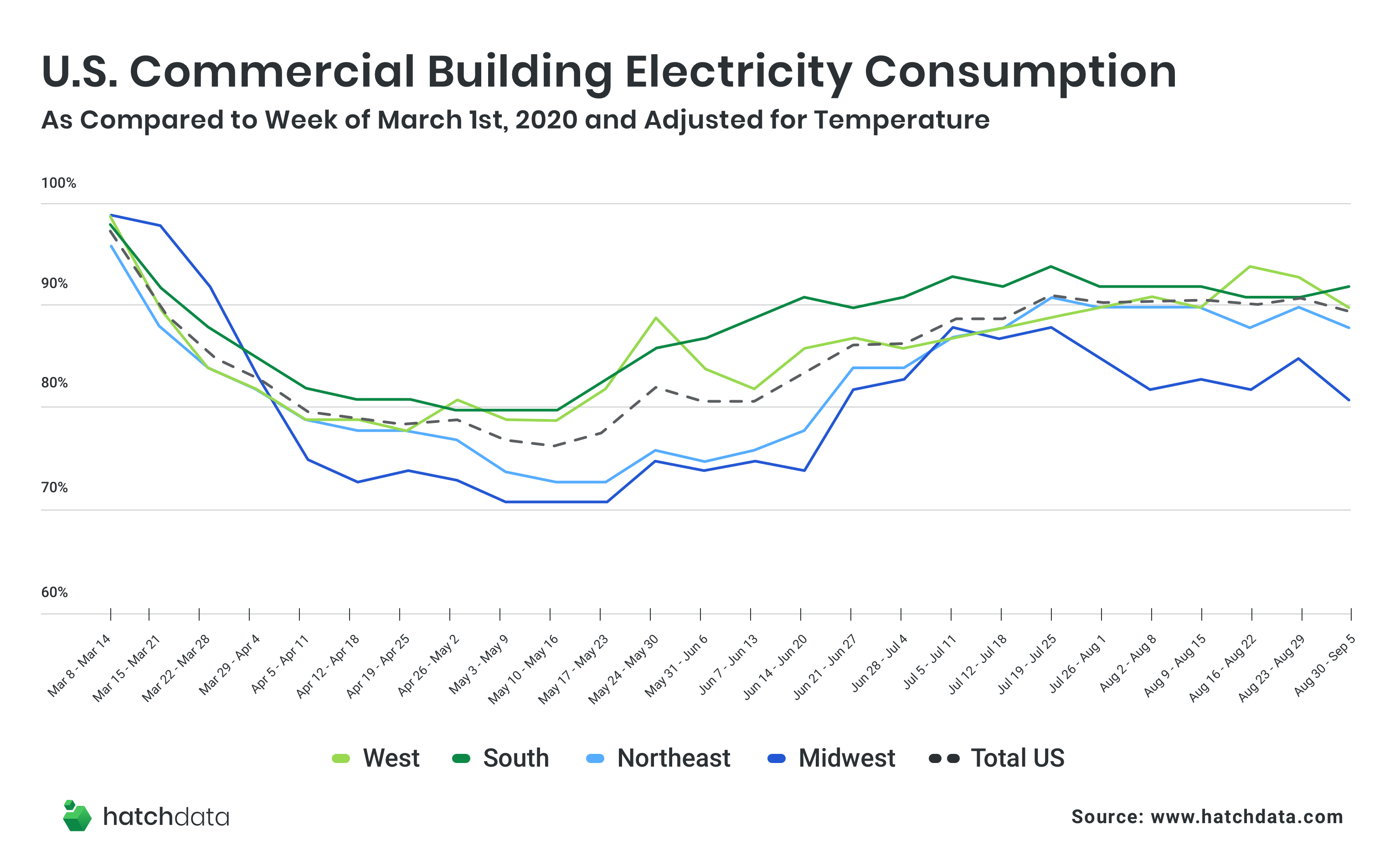by Brianna Crandall — October 21, 2020 — New national data from Hatch Data, a commercial building operations performance management software company, shows that after dropping 24% during the height of the coronavirus crisis in May, US office building energy (electricity) consumption has risen back closer to historical levels and is within about 10% of pre-COVID-19 levels on average.
Said another way, national electricity consumption, when adjusted for temperature, dropped to 76% of the pre-pandemic level and has risen to 89% of the pre-pandemic level as of September 5, 2020. The low point, on a national level, occurred the week of May 10.
There is some variation across geographic regions of the US in the extent of the energy use decline and increase, and the timing, reflecting when stay-at-home orders were issued in various regions and when they were lifted.
- Northeast: Electricity consumption dropped to 73% and has since risen to 88%. The low point occurred the week of May 10.
- West: Electricity consumption dropped to 78% and has since risen to 90%. The low point occurred the week of April 19.
- South: Electricity consumption dropped to 80% and has since risen to 92%. The low point occurred the week of April 26.
- Midwest: Electricity consumption dropped to 71% and has since risen to 81%. The low point occurred the week of May 3.
Two key questions
Hatch Data tracks and analyzes building data on more than 450 million square feet of occupied space. The company has a comprehensive data set of over 14 billion hours of property operating data collected over 10 years. The data is aggregated from utility meters, submeters, and a range of building equipment and devices at the property level. With this data and intelligence from building operators that use the company’s software, Hatch Data has insight on key questions, including the following two.
1/ Why didn’t electricity usage decline more than 24% nationally when buildings in most metropolitan areas were virtually unoccupied?
Despite the reduced levels of occupancy during the pandemic, the desired or optimal state is not a mothballed building. Many building systems need to run to prevent degradation, protect occupant health, minimize risk of failure, and ensure they’re ready to ramp up quickly when tenants are able to return to work.
Also, in most cases lease obligations compel landlords and their operating teams to continue to maintain certain temperatures and hours in conditioned spaces. Lease language varies, but it’s common for these obligations to remain — even in a crisis situation — unless tenants explicitly consent to variances. In addition to comfort systems, essential 24/7 loads such as smaller server rooms, telco closets, and emergency lighting remain in most buildings, leading to a persistent level of energy usage.
Still, Hatch Data found that best-in-class buildings were able to able to reduce energy consumption by upwards of 40% or more at the height of the lockdown period. The company says that this discrepancy (between the national average of 24% and 40%) underscores the sizable opportunity to increase building operational efficiency by seizing the moment to make lasting changes in building operations.
2/ Why has usage climbed to 89% when building occupancy on a national level is hovering only between 25% and 50%?
Preparing for reoccupancy accounts for the increase in energy consumption from the low points seen during the pandemic, including satisfying tenant lease requirements (as noted above) for spaces that already are reoccupied. At the same time, building operators are dealing with heightened health and safety issues, some of which require energy to meet.
For example, ASHRAE has recently released guidance on preventive measures that operators can execute with respect to heating, ventilation and air-conditioning (HVAC) systems. One suggested strategy is to increase outdoor air ventilation, install higher-rated filters, and increase cleaning protocols.
These adjusted operating parameters and inconsistent guidance on regional reentry have operators and owners in a leading position to demonstrate preparedness in advance of workers returning, concludes Hatch Data.
For more information about Hatch Data’s operations performance management software platform for commercial real estate, see the company’s website. Hatch Data empowers operators with real-time building data and advanced analytics to optimize property operation and streamline utilities expense management.







